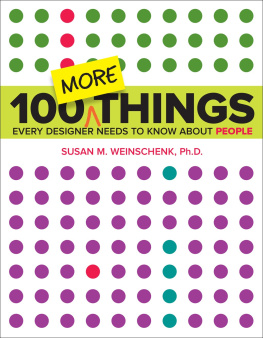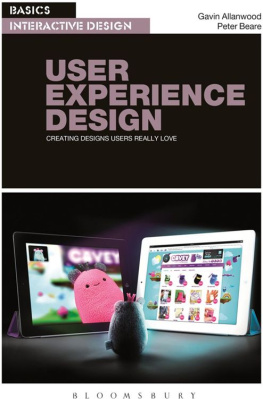Copyright 2016 Joel Marsh. All rights reserved.
Printed in Canada.
Published by OReilly Media, Inc., 1005 Gravenstein Highway North, Sebastopol, CA 95472.
OReilly books may be purchased for educational, business, or sales promotional use. Online editions are also available for most titles ( safaribooksonline.com ). For more information, contact our corporate/institutional sales department: (800) 998-9938 or corporate@oreilly.com.
The OReilly logo is a registered trademark of OReilly Media, Inc. UX for Beginners and related trade dress are trademarks of OReilly Media, Inc.
Many of the designations used by manufacturers and sellers to distinguish their products are claimed as trademarks. Where those designations appear in this book, and OReilly Media, Inc., was aware of a trademark claim, the designations have been printed in caps or initial caps.
Although the publisher and author have used reasonable care in preparing this book, the information it contains is distributed as is and without warranties of any kind. This book is not intended as legal or financial advice, and not all of the recommendations may be suitable for your situation. Professional legal and financial advisors should be consulted, as needed. Neither the publisher nor the author shall be liable for any costs, expenses, or damages resulting from use of or reliance on the information contained in this book.
This Book Truly Practices What It Preaches
It started as an email newsletter, grew into a blog, became viral, and now you have it. The format of the book is based on science and research with real readers. It was then reviewed by some of the industrys leading UXersall to make it as engaging and useful as possible. We even gathered feedback from the Internet while we were writing it!
This Book Exists Because It Is Needed
(i.e., My user research uncovered a problem.)
Originally, these lessons were an email newsletter. Throughout my time working with startups, famous global brands, and in-house product teams, I was asked the same basic UX questions over and over, everywhere I worked. So, I decided to start a newsletter of UX ProTips, for my coworkers.
Once a week, I would write a short, funny lesson about one simple UX thing and email it to the company. These people were busy, and not experts, and they needed to be entertained if I expected them to learn about someone elses job (mine).
In other words, they were beginners.
At first, I was worried about seeming arrogant or annoying, but everybody loved it! They even started sending me questions to answer. It didnt take long before I started hearing my answers being repeated to clients in meetings, and people outside of our company would reply, asking how they could subscribe!
Soon after that, I noticed that the most popular question in UX forums was What should I read to get started in UX? And thus, my ProTips became a blog: www.TheHipperElement.com . My first big project for the blog was the UX Crash Course. Thirty-one daily lessons about the most fundamental things in UX, which I posted every day in January, 2014. It was a huge success. Much bigger than expected. That Crash Course has now been read over a million times without paying a cent for promotion.
That blog is the motivation for this book. And if you want even more proof that there was a need, consider this: we were able to use the title UX for Beginners because it had never been used! And were talking about a job that was ranked fourteenth on a list of the most in-demand jobs in America in 2015!
Who Is This Book For?
(i.e., My user profiles)
Even if you still dont understand what I mean by UX its short for User eXperience, by the wayyoure in the right place. This book is written for three types of people: non-designers who want to become designers, managers of UX designers, and experienced people from other jobs who want to learn more about UX.
If youre a non-designer, this book is specifically for you. My mission is to create more designers by teaching the fundamentals in a simple waysomething that is surprisingly hard to find. This isnt just a book about thinking like a designer or the UX mentality, it is a practical set of lessons that teach what to do; how to be a UX designer on the first day of your first job. If youre a student, or an intern, or a recent graduate that feels intimidated by doing UX for real, welcome. We need you.
If you manage UX designers, youre either a designer yourself or you have the authority to enable or disable the designers on your team. Either way, the more time you spend managing design, the less time you spend doing design, so a refresher is always useful, especially an easy, funny one like this. But, more important, being a manager also means that you are in a position to teach UX, and this book has been created for that reason, too. Use it as a reference or as a way to kick-start conversations with your team. Sometimes the most valuable thing is a good book that backs you up.
And finally, you might have experience in something relevant, like programming, or project management, or sales, but now you need to know more about UX design. Thanks for realizing that UX is a core element in all digital products and services! This book is a great place for you to initiate yourself and learn to talk the talk while building a solid understanding of the people who walk the walk. And if you aspire to go











